Royal Union St Gilloise (USG) has made a flying start to life in the Jupiler Pro League, the former champions of Belgian football have returned from life in the second division back to the first division and have taken it by storm in the process. Having last won a league title in 1935, despite this they have the third most league titles in Belgian topflight history and if they carry on, they may claim their first league title in 86 years. USG is currently sat top of the league with 37 points and four clear of the nearest rivals Antwerp and Club Brugge, this is at the current time of writing. The club was taken over by Brighton chairman Tony Bloom in 2018 and his understanding and belief of data has played a significant role in the clubs growing development and recruitment. It isn’t often you see a newly promoted side, sit top of their division at halfway point and this led to this tactical analysis and scout report hoping to discover some of the key tactics used by Felice Mazzu’s men in their successful start to the season.
Formation / line up
Throughout this season USG have stuck with their 3-5-2 formation, as shown below with them using this 53% of the time and the next most used formation at 26% is 5-3-2 which is essentially the same formation with only the depth of the wing-backs changing. The front two this season have been Deniz Undav and Dante Vanzeir, who have been excellent upfront which we will touch upon in more detail later. In the midfield Teddy Teuma, Casper Nielsen and Damian Marcq have been the most used combination however we have also seen Loic Lapoussin feature in their too. Bart Nieuwkoop has been a mainstay at Right back. At left wingback, we have seen either Lapoussin or Kaoru Mitoma playing there. Christina Burgess has been a mainstay in the middle of the back three with either Kandouss, Bager or Van Heyden usually making up the other Centre back positions. Goalkeeper has seen Anthony Moris take the majority of minutes there, but Lucas Pirad has featured twice this season.
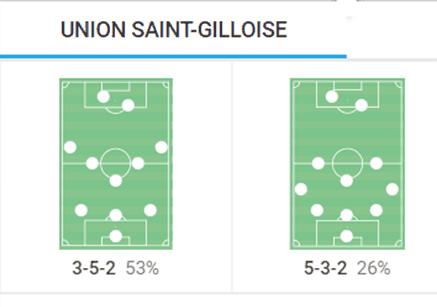
In possession
So far this season in the Jupiler Pro League, USG has scored 43 goals which are nine more than the nearest rivals Anderlecht. This is from an expected goal of 35.44 (2.09 per 90) which tells us that USG is overperforming their expected goals significantly however their expected goals tally is still the second-highest in the league just behind Anderlecht 35.6. When in possession USG use a 3-5-2 formation with the wingbacks getting high to provide the width in the team. USG really emphasize using the wide channels to both progress the ball and create chances, which we will look at in this analysis. The three Centre backs will spread out across the pitch, with the emphasis on getting the ball to the wide channels where the wingback, outside midfielder and either one of the strikers or outside Centre backs will move into the wide-area to create either an overload or passing options. Below is a great example of the way USG like to build their attacks. The outside Centre back Bager has drifted wide into the wide channel to provide passing options for Lapoussin (on the ball) and Nieuwkoop. In addition, Vanzeir has also come across to the wide channel again providing the option for Lapoussin or Nieuwkoop. This same pattern is forming on the other side. The job of both Nielsen in the game or the central midfielder and Burgess is to switch the ball from wide channel to the other. USG will look to use a combination of passes and rotations to move the ball up the field in this wide channel.
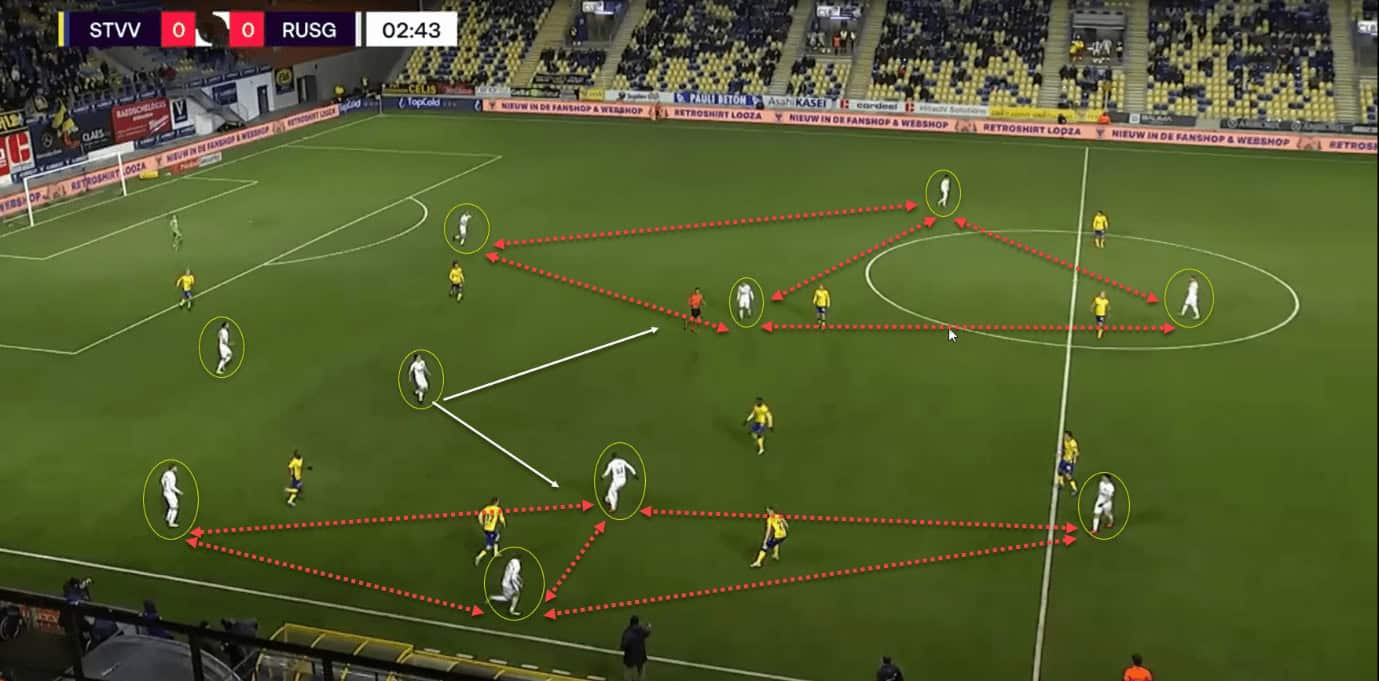
In this example, Lapoussin is going to turn and play the ball into Vanzeir, while Nieuwkoop is going to make a run along the touchline to provide a passing option for Vanzeir.
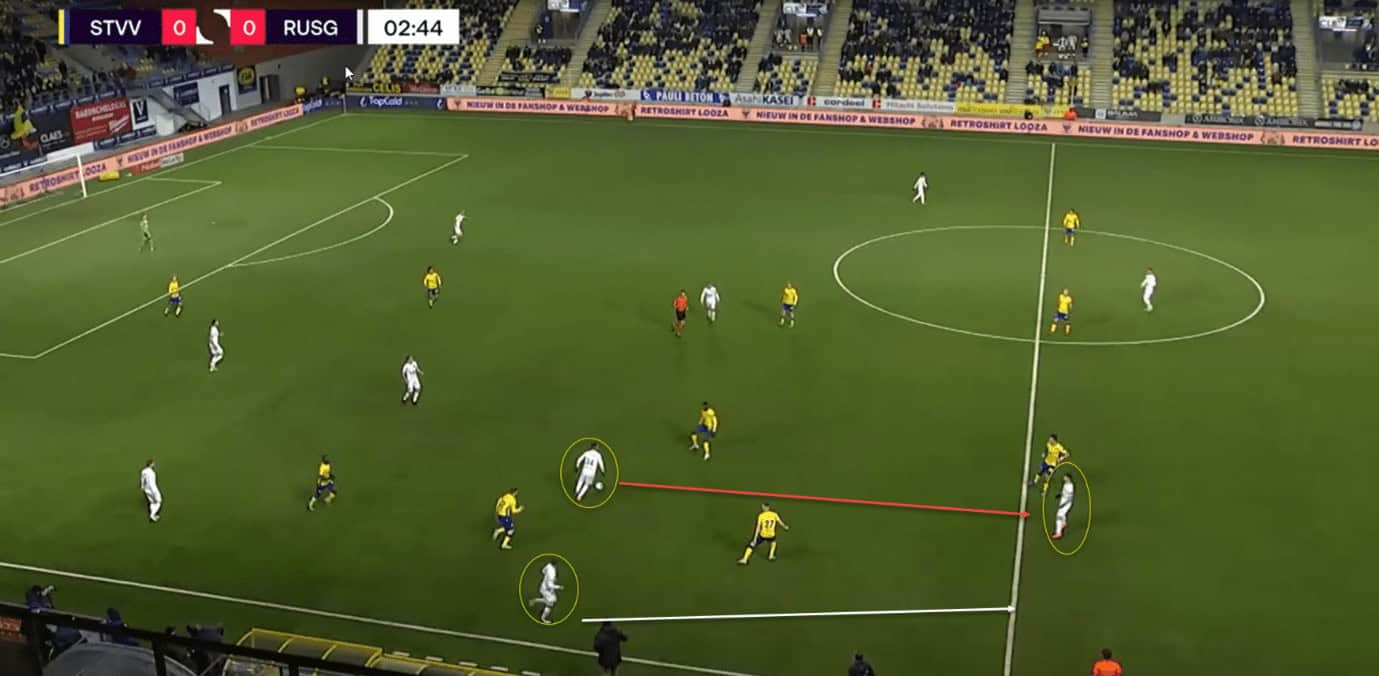
As the ball has been played in Vanzeir’s feet, he manages to skillfully evade the St. Truiden defender. He then looks to play a pass behind the defence for Nieuwkoop who is continuing his run behind the defence.
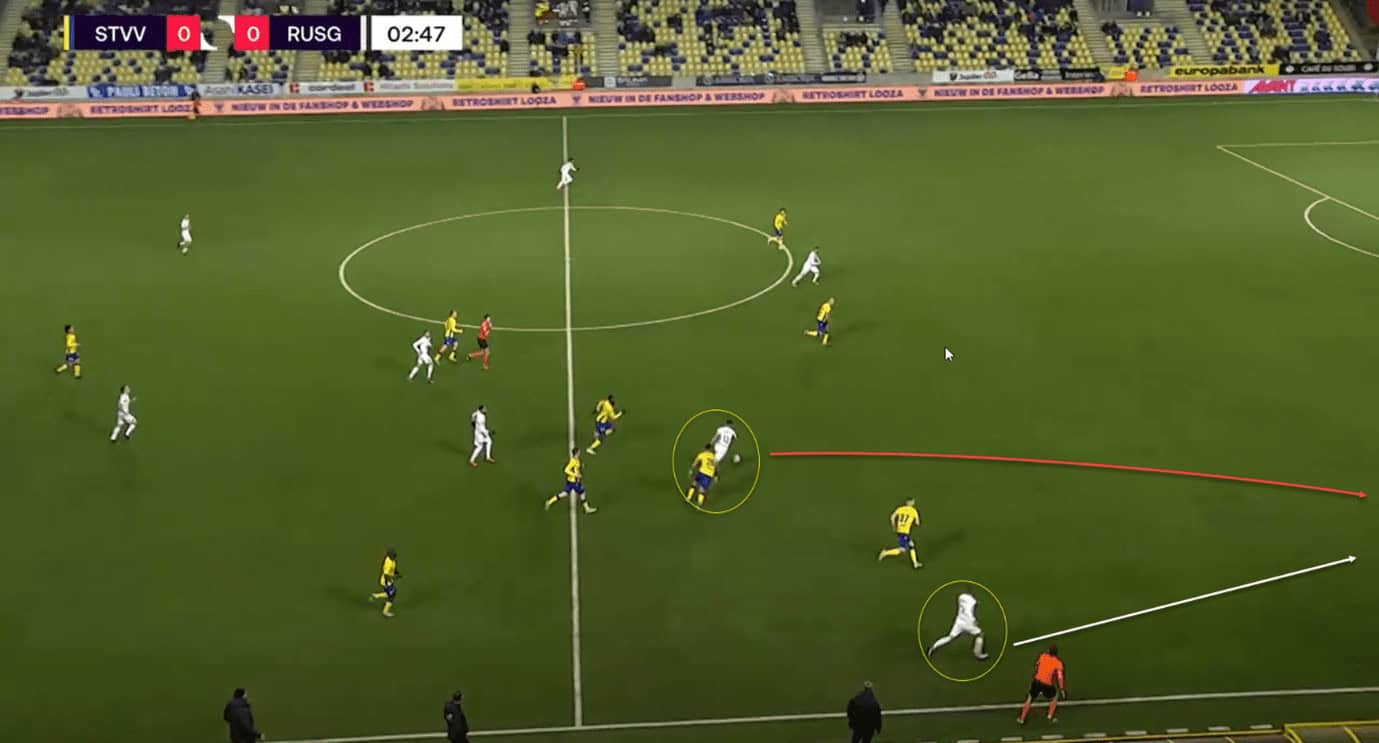
Nieuwkoop manages to meet the pass and then looks to play a cross into Undav, which is another key factor of the USG attacking play, the use of crosses to the two attackers.
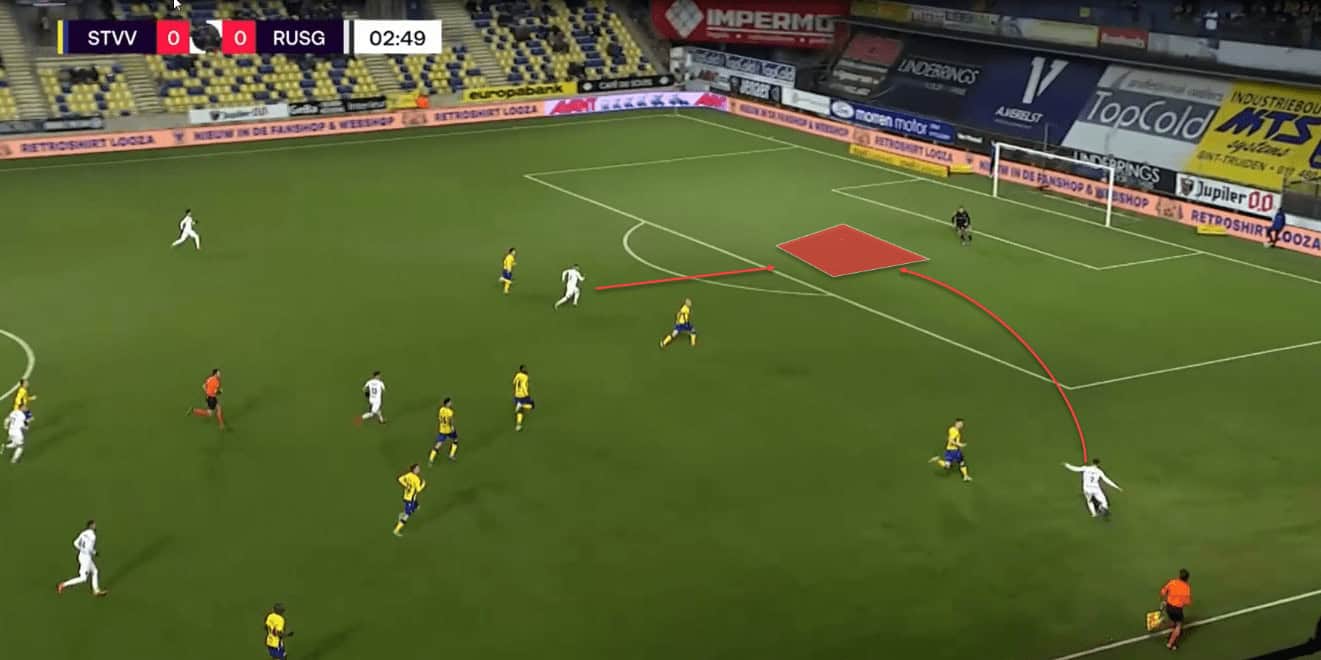
The emphasis on exploiting the wide areas ties in well with the other key proponent in USG’s attack which is crossing the ball. Another example of USG using the triangles and overloads in the wide areas comes from their home game against Charleroi. The ball has just been turned over after a loose throwing from Charleroi and again we can see the use of the emphasis on the players in the wide channel. On this occasion, Mitoma is on the ball with Marcq the central of the three midfielders moving wide to create the overload and Teuma the left midfielder in a more advanced position to receive the ball.
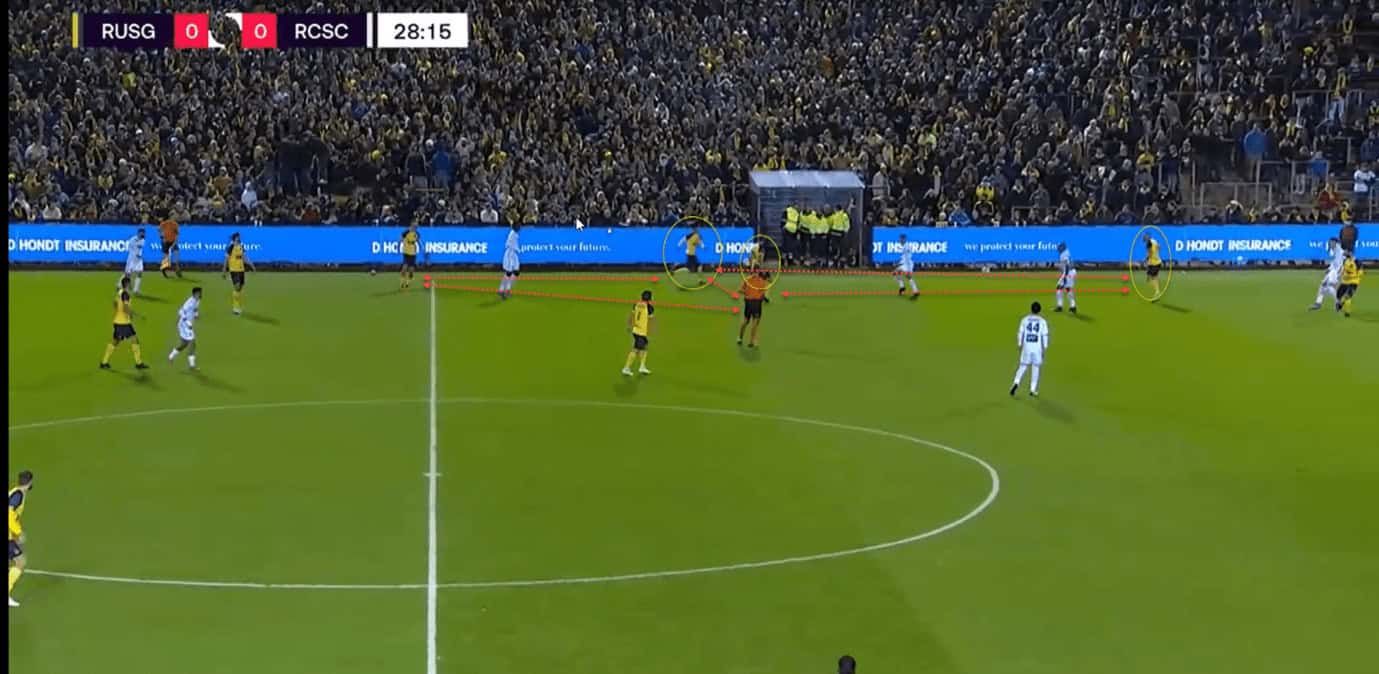
Mitoma plays the ball back to Marcq who then plays a ball between the Charleroi players to find Teuma in space.
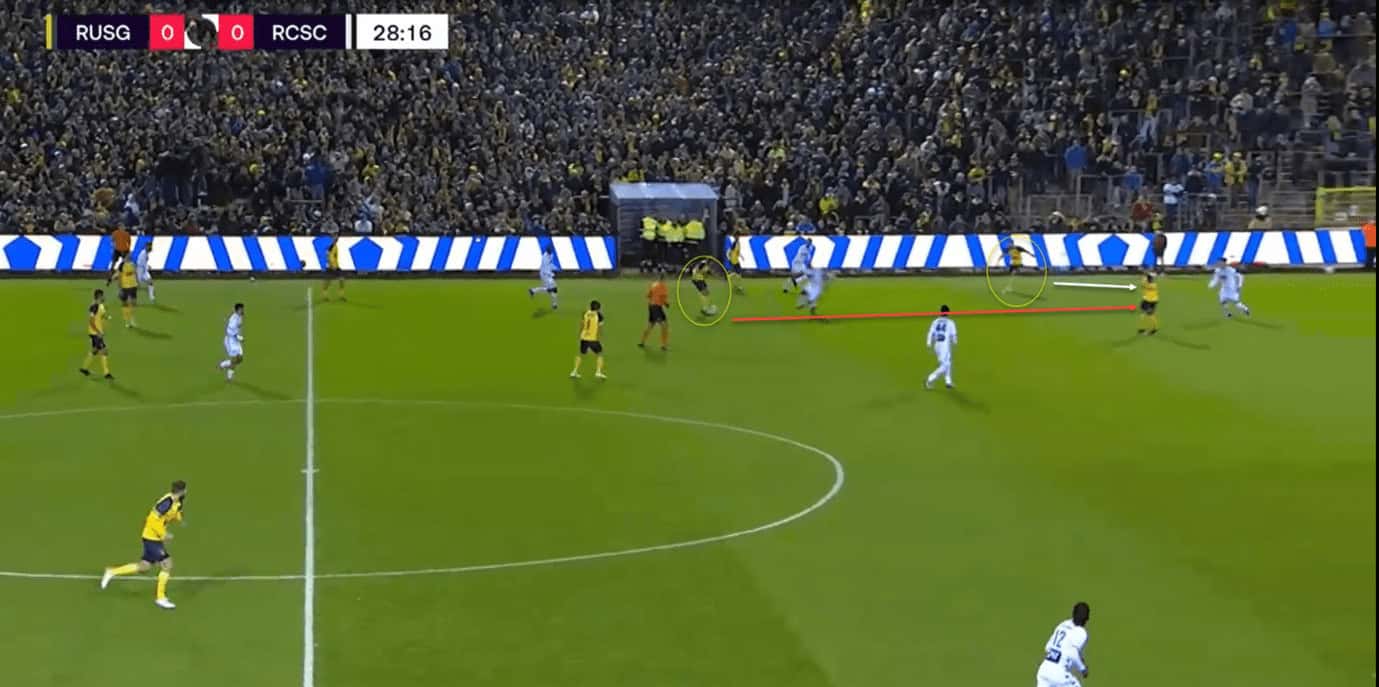
Teuma collects the ball and looks to play a cross into the box where Vanzeir is making a run across the first defender and by making this run it draws them both forward and allows both Nieukwoop and Undav to make a run behind the Centre backs and between the fullbacks. Where Undav managed to meet the ball and give USG the lead in the game.
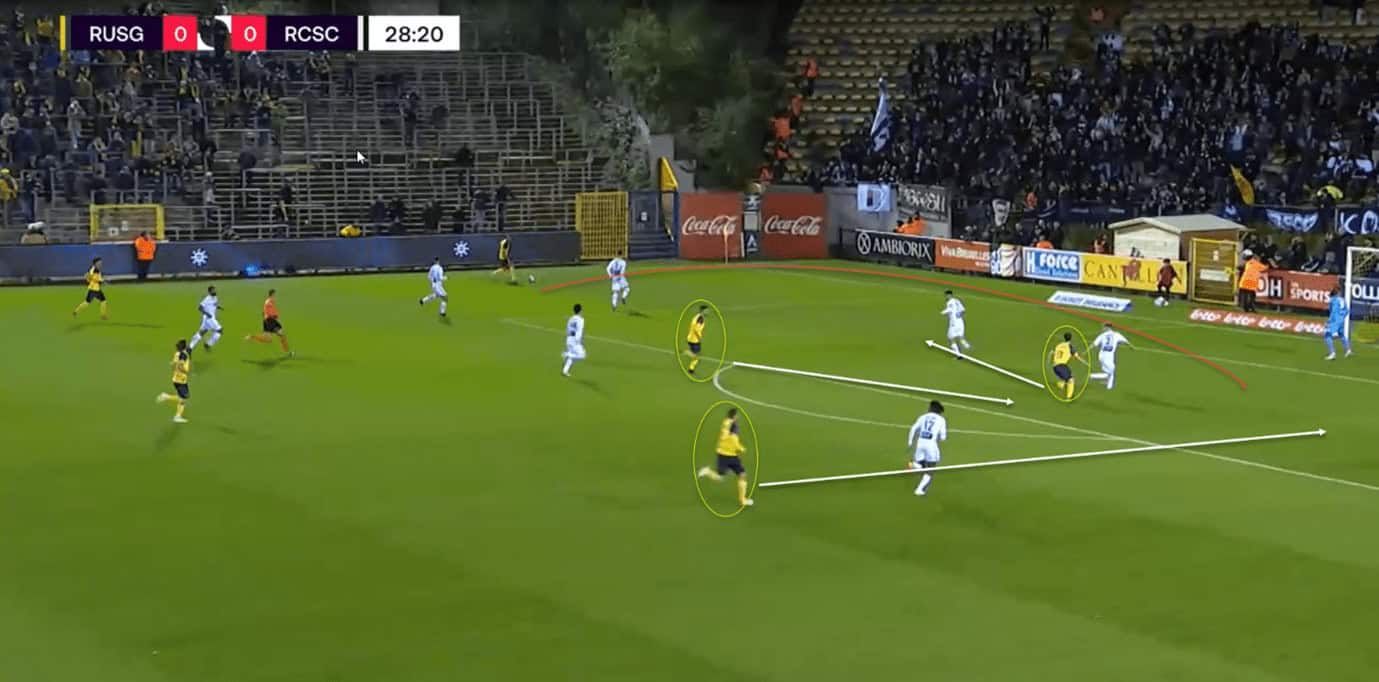
Using crosses and pullbacks to create goal-scoring opportunities
As it became apparent in the first two examples The use of crosses and pullbacks is a key tactic that USG uses to create these chances. This is made more effective by the movement of the two strikers and also the quality and delivery of the crosses. This is reinforced by the above example where Vanzeir makes a crucial run and gets to the ball before the Charleroi Centre back and flick the ball on. This run means that one, Charleroi cannot clear the ball but also attracts the Centre backs forward and creates space for Undaz to exploit. One thing that is apparent when looking at the USG crosses is that they are always delivered in an optimal way to an optimal area. By this I mean they are delivered in a way that increases the attacker’s chance of scoring, as shown below Vanzeir plays the ball along the ground which makes the finish easier for Undav. In addition, it is played to the edge of the six-yard box keeping the ball away from the keeper but also allowing Undav to attack the ball, which will increase his chance of scoring.
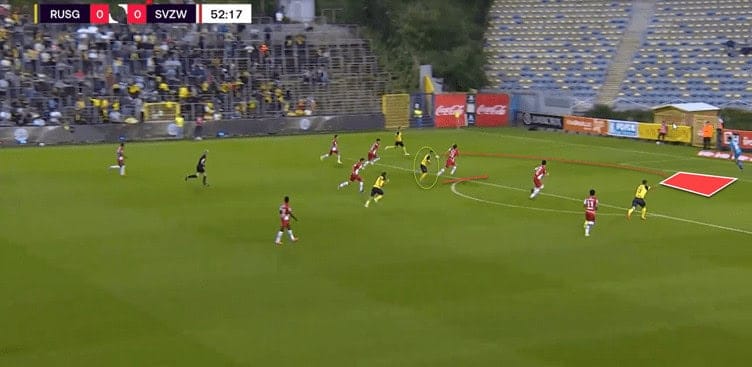
Undav attacks the ball and slots home to give him yet enough goal, he is currently on 16 for the season. In another example of USG working the ball wide and then using crosses and passes into the box comes against Waregem. The ball has been worked in behind the opposition the USG player has two emerging options on the ball, he can either play a cross across the box to Vanzeir or as the play unravels he can pull the back to Undav who makes a clever run and holds off to create a little pocket of space for him to use to get a shot off.
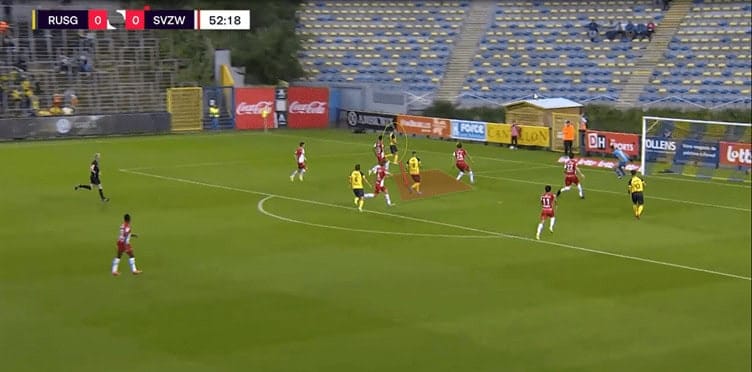
As he continues to carry the ball forward Undav has stopped his run ready for a pullback. As the ball is pulled back Undav opens himself up and slots home to give USG the lead.
Below is a cross-map from USG’s last game against St Truiden where you can see the emphasis on crosses and pullbacks to create goal-scoring opportunities. You can also see most crosses are met within the width of the goal which increases the chance of the attacker scoring.
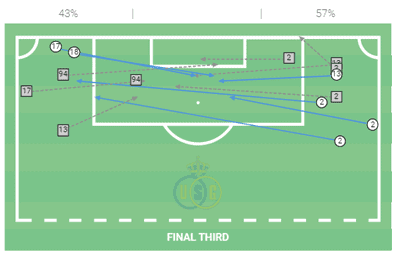
Out of possession
Defensively USG has one of the best defences in the league having only conceded 18 which is only bettered by Gent, this is supported by the expected goal numbers which indicate an XGA of 21.29. When out of possession USG like to defend in a 5-3-2 formation. Within this, the back 5 looks to remain relatively deep but also compact and organized, the midfield three work very hard to get across and act as a resolute first block. USG remain passive out of possession and very rarely look to press the opposition instead they wait for the opposition to make a mistake or frustrate them into a long ball that USG can recover. This is shown excellently by the below example, you can see the front two looking to cut off passes inside into the single pivot. The midfield three have their shape and working out to the left of the pitch to cut off any space or passing option and the back five are well-positioned and spaced. Also, USG two blocks are closely positioned to stop any ball going into the space between the blocks.
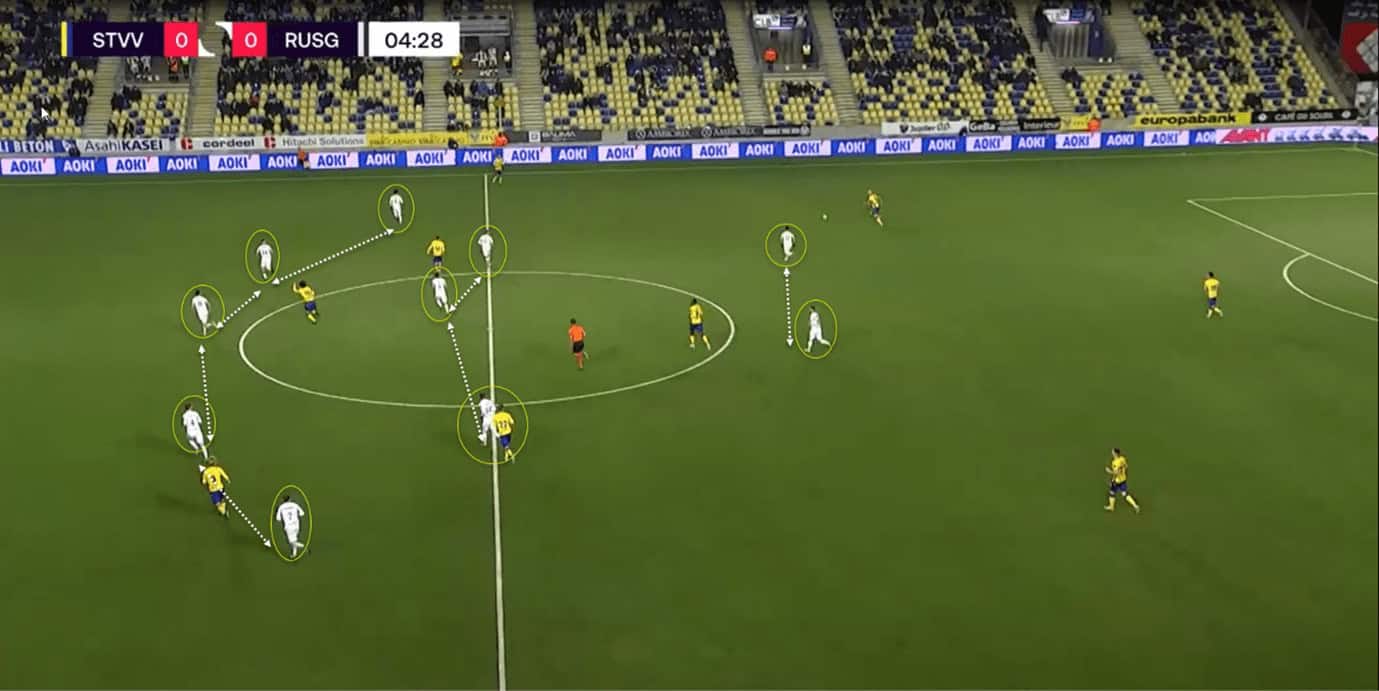
The wingbacks usually engage the fellow wingback and with many Belgian sides using wing-backs this suits USG well. the outside midfielders are key in this formation to prevent teams from overloading the wide areas. As the above example develops, we see this importance as Teuma work hard to get out and support Mitoma put also prevent the outside Centre back creating an overload. While the other two midfielders work inside in a pendulum-like motion.
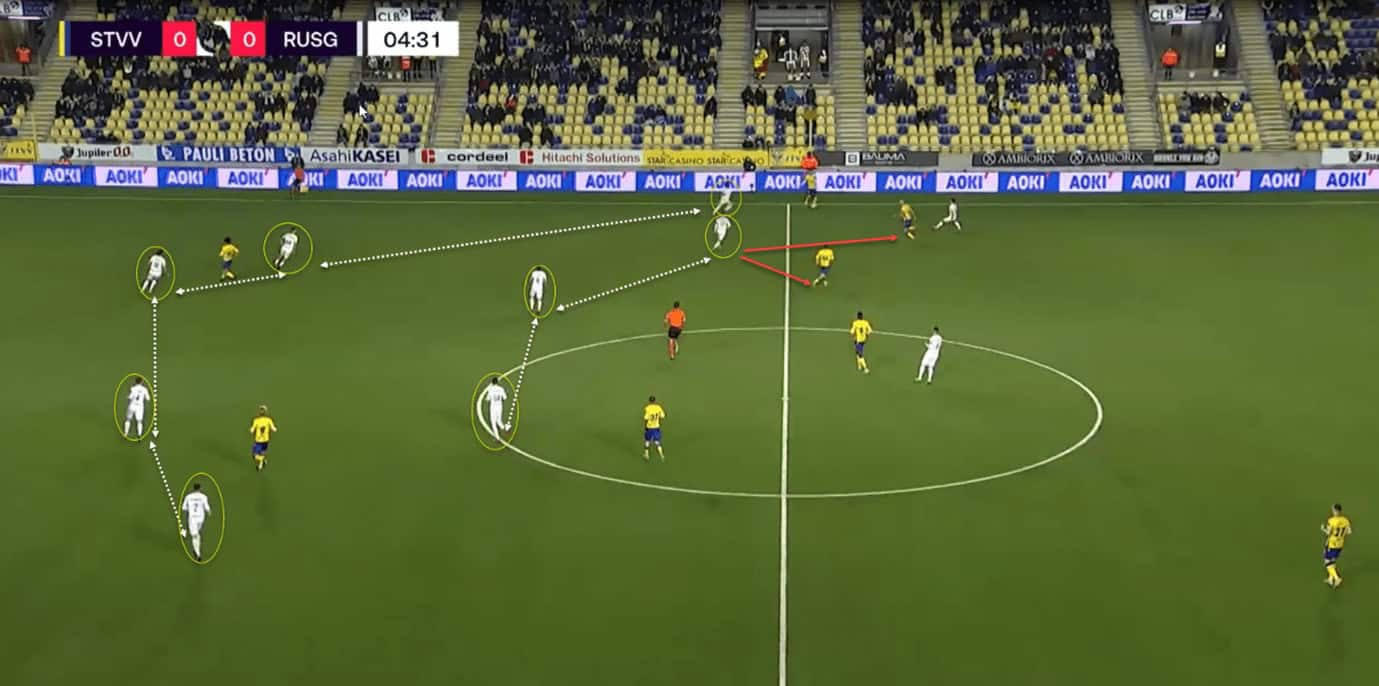
Below is another look at the low block adopted by USG in the same game and how USG continue to manage to maintain the same low block. St Truiden have the ball on the left-hand side of the pitch and you can see in this diagram how USG has managed to manoeuvre their block to that side of the field and in the process created an overload of that area but by having so many bodies in that area of the pitch it has reduced space and passing options for the opposition.
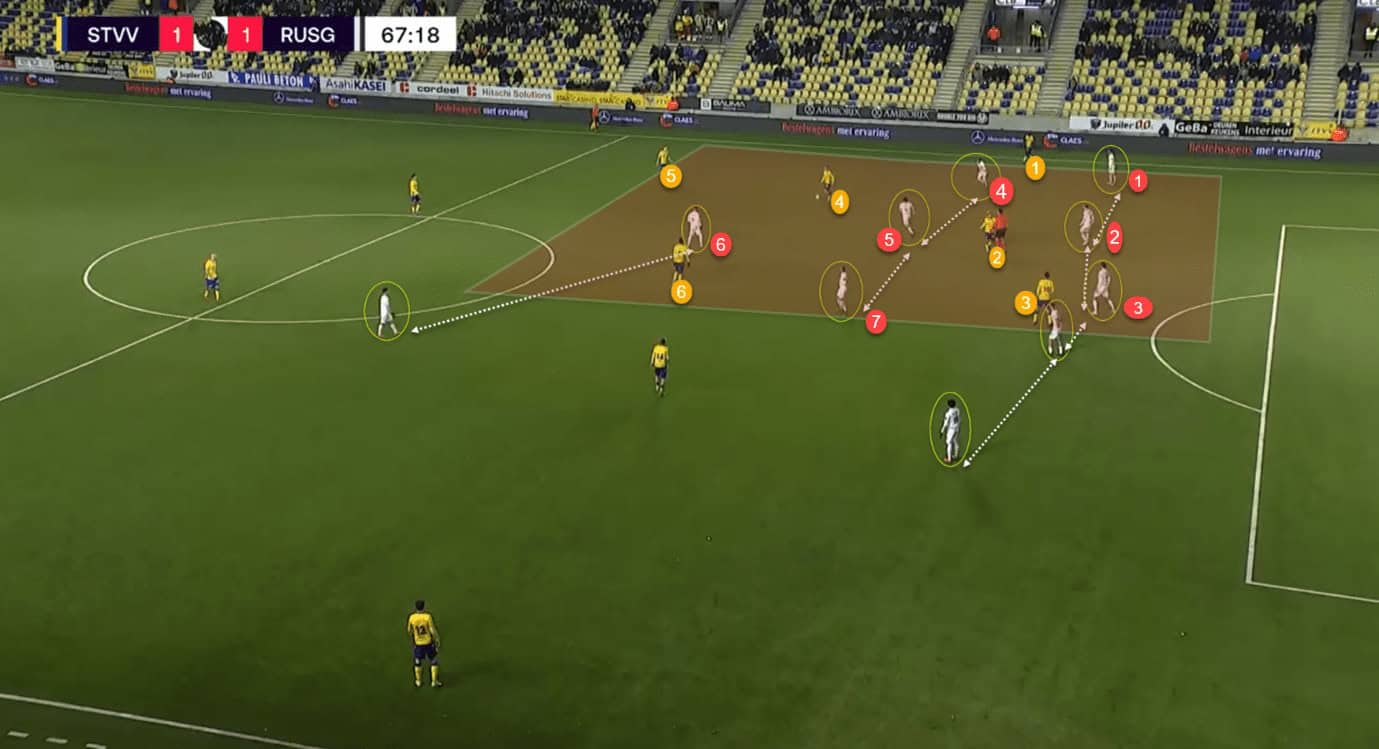
This usually leads to teams trying to force passes which then leads to a USG turnover, and they regain possession of the ball.
In transition
When USG win the ball back, they look to transition up the field quickly and efficiently, in order to do this, they use a combination of direct and vertical passes. This is an important facet of a team that likes to defend and sit in a low block if needed. In this example, USG has just won the ball in their own third. Van Heyden after regaining possession plays a pass straight into Teuma who turns and looks to progress the ball forward quickly.
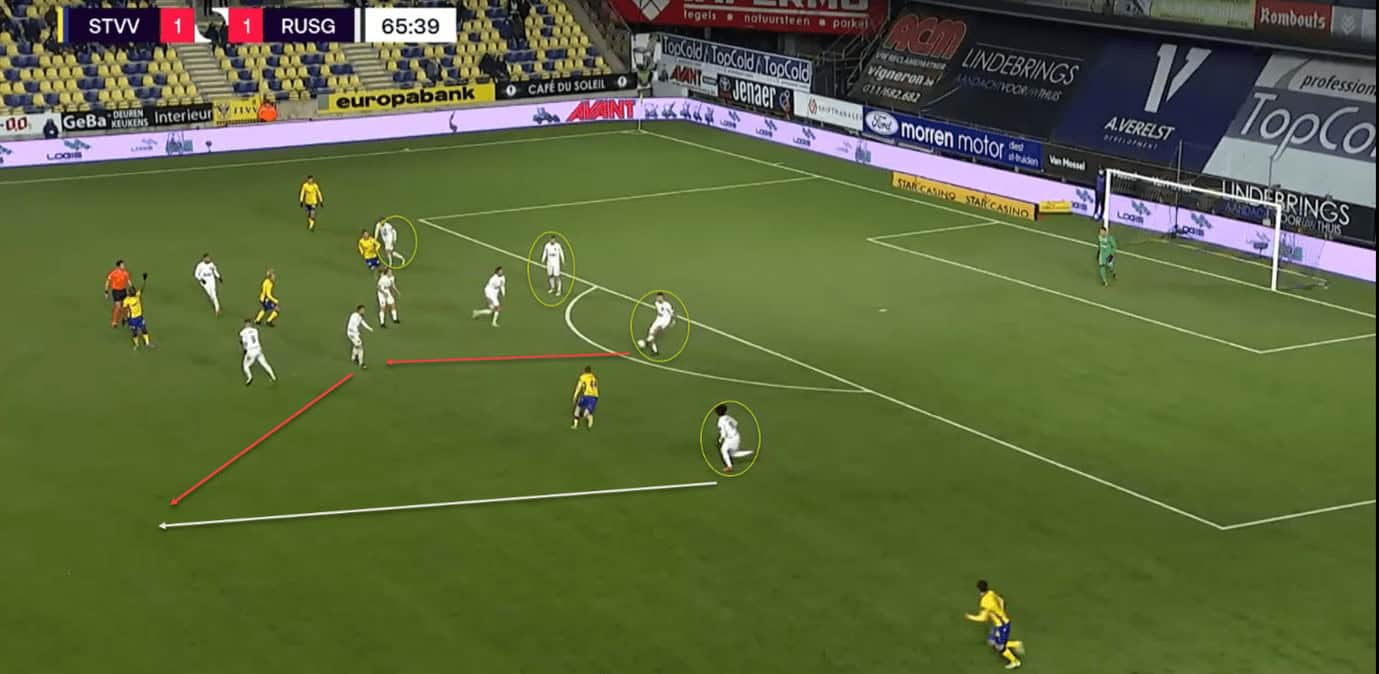
Teuma plays the ball to Undaz who then quickly releases Mitoma.
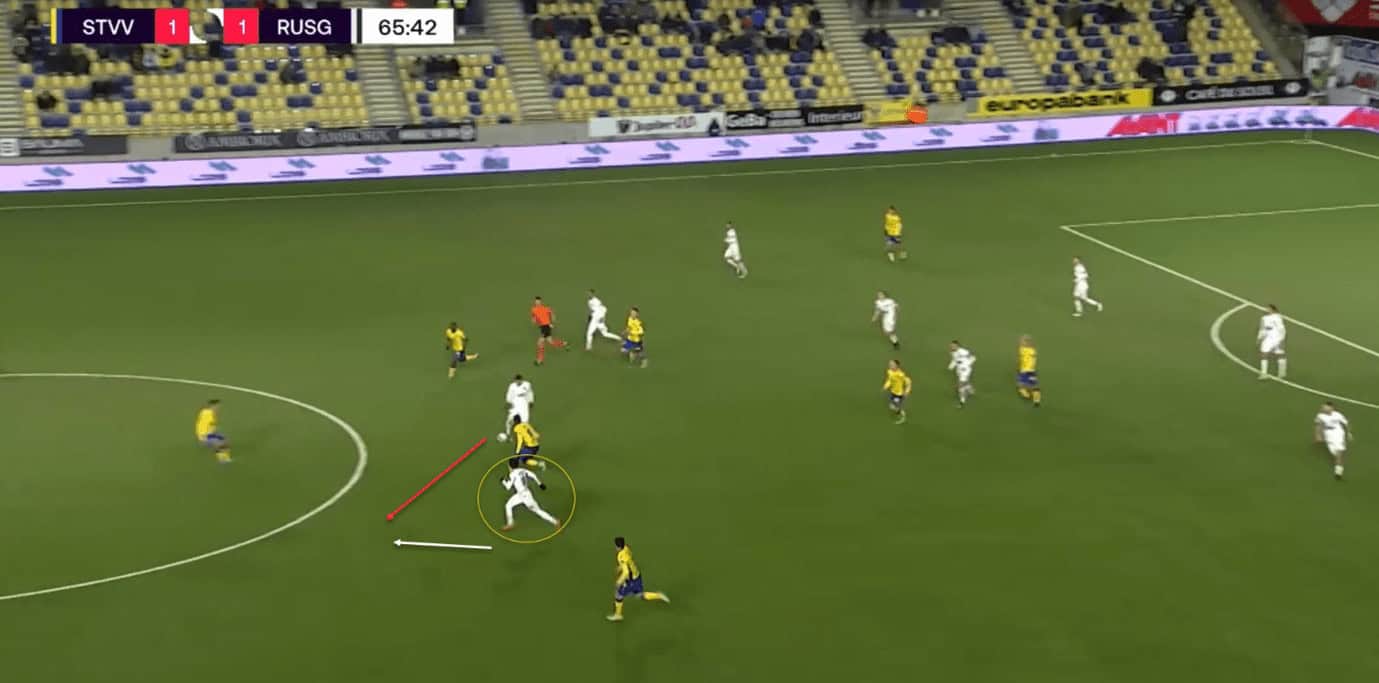
Mitoma manages to carry the ball up the field and into the opposition territory. He then looks to release Vanzeir however slightly overhits his pass. However, it still has allowed USG to get up the field and if Mitoma didn’t overhit his pass Vanzeir would have had a goal-scoring opportunity.
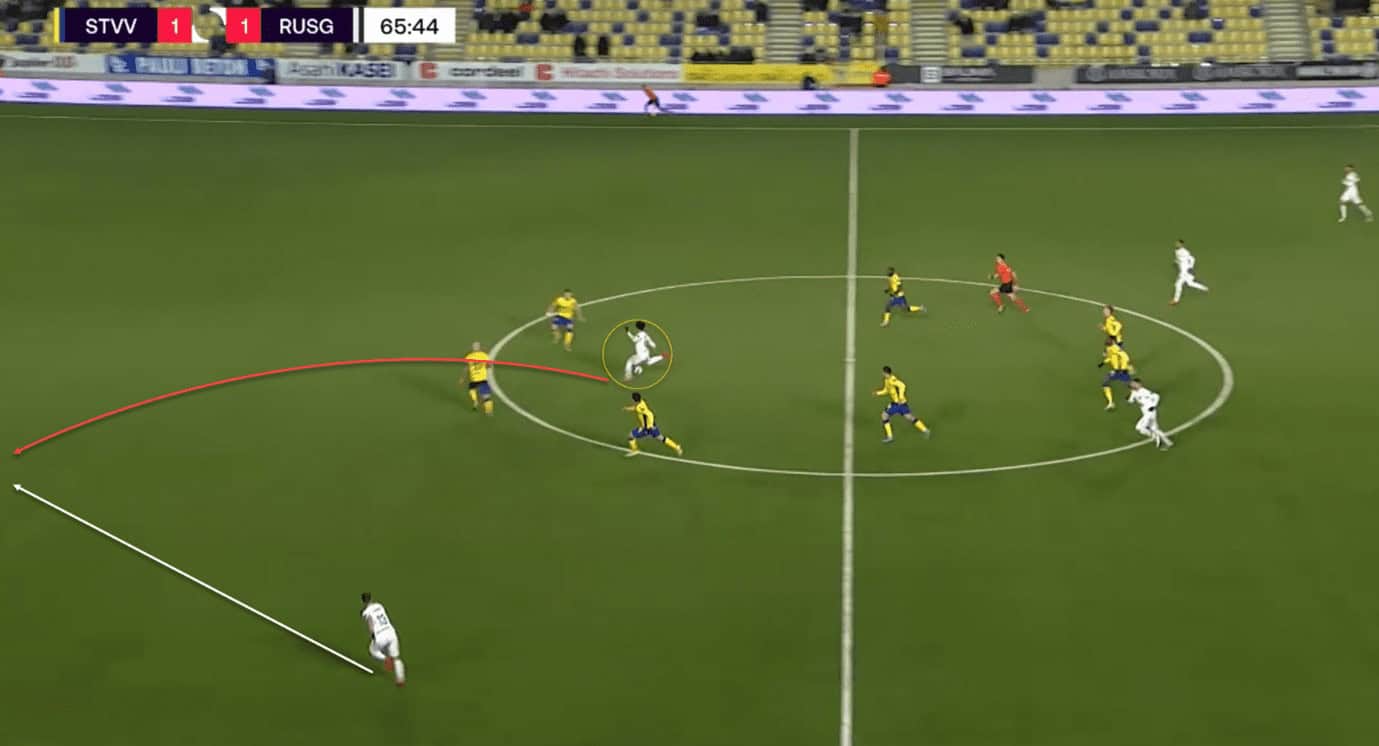
The ability to transition quickly and efficiently up the field is essential to USG and how they play, it allows them to main a rigid defensive structure and pounce on any opposition errors and put themselves onto the attack quickly.
Conclusion
USG are a fascinating side not just because of their story but also tactically too and hopefully, this tactical analysis has helped explain some of their core tactical principles. Felica Mazzu has carefully constructed a tactically astute and well-drilled team that know exactly what they are doing in all aspects of the game. Their emphasis is on overloading wide areas and then getting players in the space to either cross the ball or pull back to one of the two in form exciting striker. Defensively the well-constructed low block has been fruitful this season with them achieving one of the best defences in the league, these low block strategies ties in brilliantly with their ability to quickly transition up the field. It will be interesting to follow and observe whether they can continue their form and eventually lift the title at the end of the season with both Antwerp and Club Brugge closing in. Then we may get to see them venture into Europe next season whether it’s the Champions League, Europa League or Conference league.

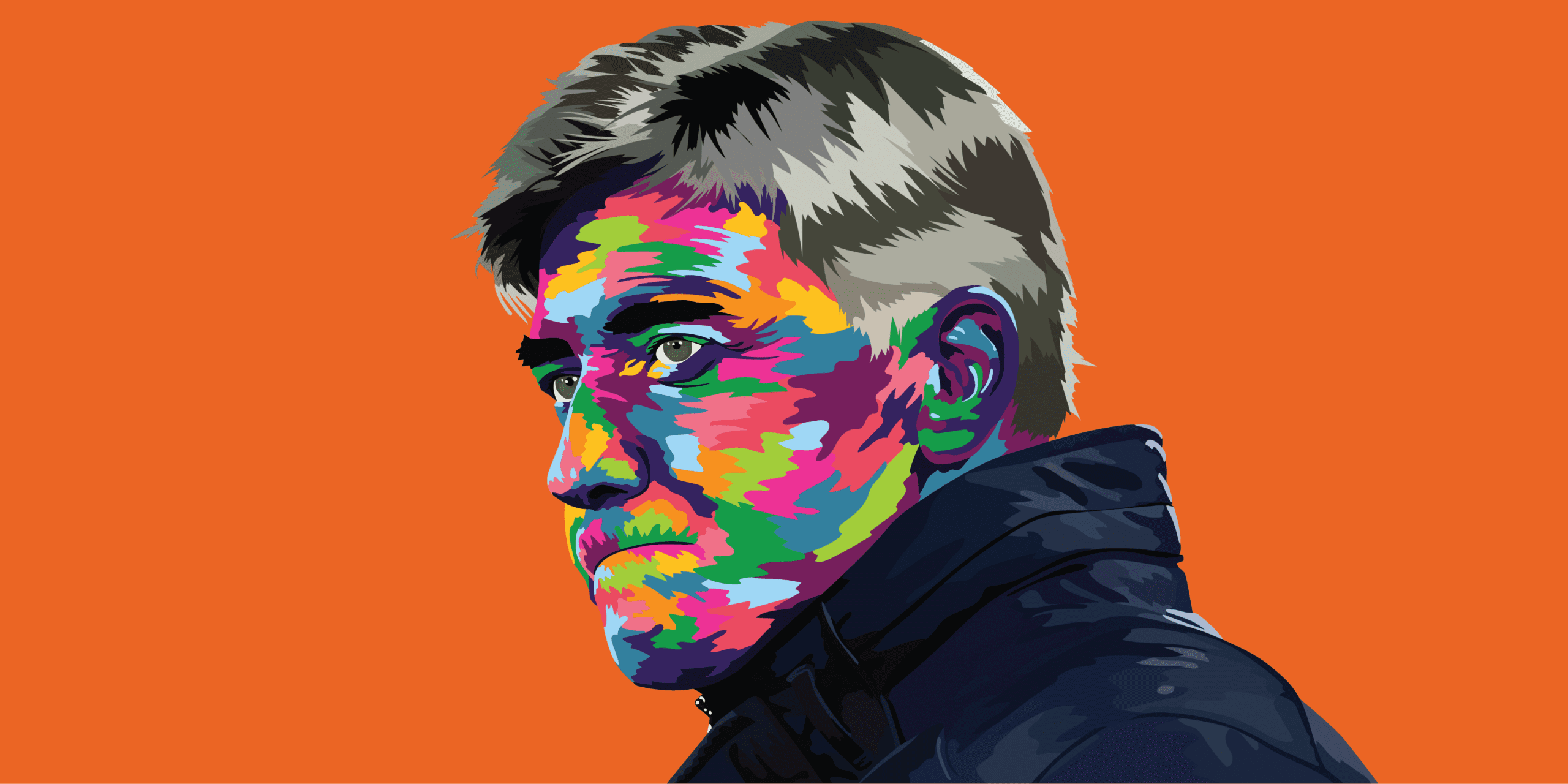




Comments